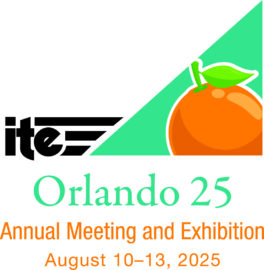Workshops
(separate fee required)
Sunday, October 21, 1:00 – 5:00 p.m.
Developing A Plan For Deploying A Connected Vehicle Environment
(Pathway: Planning/Design)
Room 104
This four-hour workshop is the third in a series of Connected Vehicle (CV) courses offered by the ITS JPO Professional Capacity Building program. he purpose of this course is to help transportation agencies that are beginning to plan implementation of a CV environment. The course broadens each participant’s understanding of the technology and systems engineering activities required to support a CV environment through the use of activities and examples from the CV Pilot sites and other ITS deployments. The overall goal of the course is to teach participants how to develop an action plan in collaboration with regional partners to improve readiness for CV deployment. Participants will learn more about the safety, mobility, and applications and will gain an overview of three CV pilot sites in Wyoming, New York City, and Tampa. They will also learn how to identify funding sources for CV projects. Lastly, they will be made aware of recent activities supported by the ITS Joint Program Office and resources available from the CV research program sponsored by the U.S. DOT.
Learning Objectives:
- Understand the technology and systems engineering activities required to support a CV environment.
- Describe how to develop an action plan in collaboration with regional partners to improve readiness for CV deployment.
- Identify activities and examples from the CV Pilot sites and other ITS deployments.
- Describe funding sources for CV project as well as resources available from the CV research program sponsored by the U.S. DOT.
Registration fee: $50
Maximum number of participants: 30
National SPaT Challenge Workshop: Goals, Concepts and Resources
(Pathway: Planning/Design, Implementation)
Room 108
The National Signal Phase and Timing (SPaT) challenge goal is to encourage state or local agencies throughout the United States to deploy Dedicated Short Range Communications (DSRC) infrastructure with broadcasts of Signal Phase and Timing (SPaT) at approximately 20 intersection locations in each state by January 2020, typically in a corridor or network setting. Working with industry leaders through the Cooperative Automated Transportation (CAT) Coalition, the SPaT Challenge Tactical Working Group with the National Operations Center of Excellence (NOCoE) is providing this workshop to inform, communicate and share knowledge to the rural ITS community. The workshop will provide an overview of the challenge, resources that are available (concept of operations, lessons learned, design, procurement and implementation) and ways for participants to be able to encourage the deployment of Connected Vehicle applications in their organizations by starting with the broadcast of SPaT and MAP messages.
Learning Objectives:
- Describe the SPaT Challenge and the deployment Dedicated Short Range Communications (DSRC) infrastructure.
- Understand resources that are available to support the SPaT Challenge (concept of operations, lessons learned, design, procurement and implementation).
- Identify ways for individuals to be able to encourage the deployment of Connected Vehicle applications in their organizations by starting with the broadcast of SPaT and MAP messages.
Registration fee: $50
Maximum number of participants: 30
Wednesday, October 24, 1:00 – 5:00 p.m.
Smarter Work Zones
(Pathway: Safety)
Room 104-105
Stemming from the FHWA Every Day Counts initiative, Smarter Work Zones (SWZ) offer tools for effective traffic management during construction and are necessary to ensure motorist and worker safety, minimize travel delays, maintain access to local businesses and residences, and complete road work on time. This workshop will present technology applications such as queue management and speed management that involve deployment of Intelligent Transportation Systems (ITS) for dynamic management of work zone traffic. Queue management systems, especially when coupled with real-time traveler information strategies, can warn drivers to a line of vehicles ahead caused by a work zone so they can slow down safely. Speed management solutions, especially variable speed limit (VSL) systems, dynamically manage work zone traffic based on real-time conditions such as congestion and weather. Combining VSL with automated enforcement can increase driver compliance with displayed speed limits. Both queue and speed management use a range of technologies for detection, including Bluetooth® sensors and probe vehicles. In addition, this workshop will provide an overview of the Work Zone Impacts and Strategies Estimator (WISE) software as well as other key aspects of different types of SWZ technology applications such as: Dynamic Lane Merge, Incident Management, Entering/Exiting Construction Vehicle Notification, and Performance Measurement
Learning Objectives:
- Describe technology applications such as queue management and speed management that involve deployment of Intelligent Transportation Systems (ITS) for dynamic management of work zone traffic.
- Understand how combining variable speed limit with automated enforcement can increase driver compliance with displayed speed limits.
- Describe attributes and results from using the Work Zone Impacts and Strategies Estimator (WISE) software.
- Identify key aspects of different types of SWZ technology applications such as: Dynamic Lane Merge, Incident Management, Entering/Exiting Construction Vehicle Notification, and Performance Measurement.
Registration fee: $50
Maximum number of participants: 30

